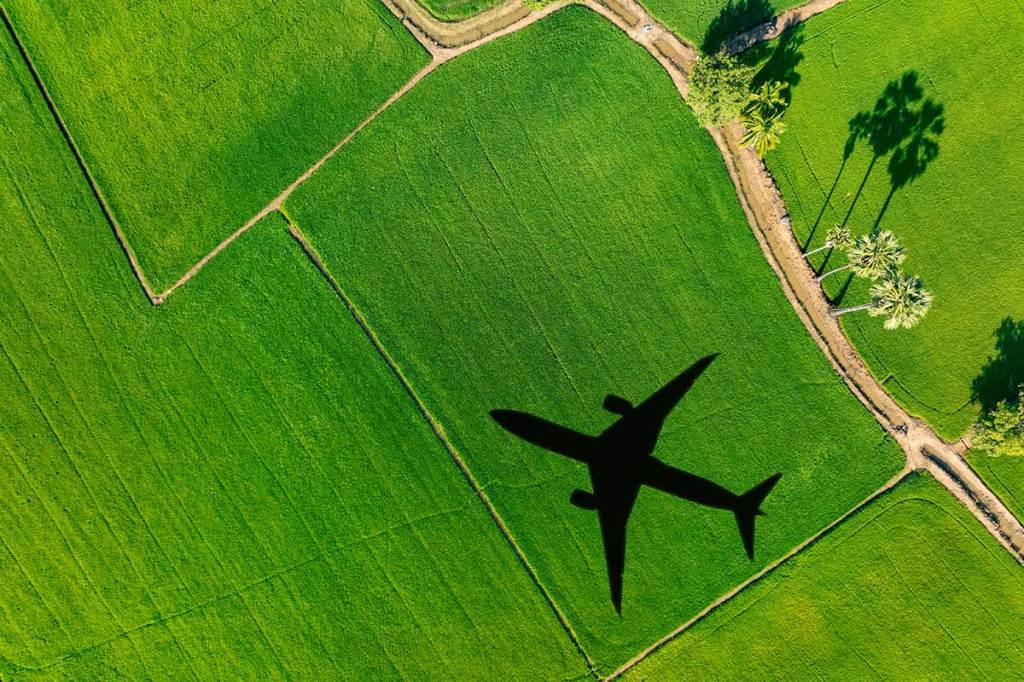Introducing the latest myCWT product and service enhancements
Building on our digital, omnichannel myCWT platform, our new products and services will simplify travel management for you and your employees – anytime, anywhere, anyhow.
Note: Featured services may not be available in your country at this time. Please reach out to your CWT representative for more details.
Hear from Chief Product Officer, Erica Antony as she shares the key product highlights of 2024, along with the key areas driving innovation.
-

2040: Baseline, Boom or Bust
As we enter an era of rapid transformation and unprecedented challenges, it is essential for travel managers, meeting & event planners, and corporate decision-makers to look ahead and frame our current strategic thinking with a clear vision of the future. Business travel and meetings and events (M&E) are poised for significant change over the next decade and a half, driven by a complex interplay of sustainability goals, technological advancements, evolving work models, and geopolitical dynamics.
In this paper to mark the 10th anniversary of our Global Business Travel Forecast, we explore, for the first time, a long-term vision of the future and potential trajectories through three distinct scenarios, each offering insights into how these forces should affect policy-making, budgeting and priorities. By examining these scenarios, we can better understand the diverse possibilities that lie ahead and the strategic imperatives required to thrive in each potential future.
Based on trajectory data analysis and interviews with industry leaders, behaviorists and climate tech founders, this forward-looking approach enables us to anticipate changes, strengthen our strategies, and make informed decisions that align long-term objectives. It is through this lens of foresight and adaptability that we can build resilience, seize opportunities, and navigate the complexities of the future.
We invite you to reflect on the insights presented, and consider how your organization can prepare for the opportunities and challenges that lie ahead. Together we can ensure that travel and meetings remain catalysts for growth, scalability and sustainable practices.
- Scenario development is both an art and a science
- Megatrends Shaping the Future of Business Travel, Meetings and Events
- Sustainability goals the new crux of corporate policy
- Technology Revolutionizes Travel Management
- Modern work models spark new travel patterns
- Changing demographics open doors to new opportunities
- Three Scenarios: Base case, boom and bust
- Future-proofing strategies

-

CWT GBTA Global business travel forecast 2025
When it comes to pricing, global business travel has finally reached an enduring, higher baseline. Prices will continue to rise in 2025, but only moderately, so expect a period of normalized growth.
However, this pricing environment, one of marginal gains and price regularity, is fragile. Global leisure travel has now realized a lot of its pent-up demand, while corporate travel has been resurgent, with 2024 edging at preCovid levels.
There are many factors at play, whether its volatile oil prices, labor costs and constraints, inflationary pressures, and geopolitical factors. As this elevated baseline edges upwards, albeit marginally, travel budgets will come under increased scrutiny, especially as travel patterns and attitudes change.
It’s why business travel can’t be viewed in a silo, and the true value to an organization must be fully realized. This forecast can help with those calculations.

-

Capitalize on emerging technologies in corporate travel
Technological advancements are accelerating at an unprecedented pace. How will emerging innovations like Generative AI, blockchain, and self-sovereign identity (SSI) transform corporate travel?
BTN and CWT probed global CEOs, travel managers, industry consultants and tech experts on the promises, questions, and expectations these innovations raise and how they are set to reshape traveler experience, cost control and service delivery in corporate travel and events.
Download and discover
- The technologies that will have the greatest impact on corporate travel in the next 2-5 years
- How these emerging technologies are poised to control costs, enhance service and security, and boost efficiency
- The critical challenges, opportunities, risks and roadblocks each innovation raises
- What travel managers, buyers and experts anticipate from these innovations

-

Global Forecast Calculator 2025
Submit your travel budget and find out how the latest pricing trends will impact your 2025 program with our forecast calculator.
-

Climate physics is a gamble. Here are 3 strong bets in the bid to decarbonize travel
When meteorologist and hurricane specialist John Morales cried, on air, while reporting on then oncoming Hurricane Milton, viewers empathized with his grief in the face of an advancing cloud of chaos forming before us. It felt symbolic of a bigger, global malaise.
“Nothing is certain in the casino of climate physics,” says climate writer Ben Cooke. We know that climate change is here but how and where will it manifest next and what can we do to stem it?
One thing is certain. The more carbon we pump into the atmosphere, the more climate change will worsen. Central, therefore, to reducing emissions is an awareness of the biggest trends to reduce them and using it to guide employee education, tracking and reporting and ultimately, policy.
CWT and GBTA report, 2040: Baseline, Boom or Bust explores three potential scenarios for the future of business travel and events driven by a convergence of technological advancements, evolving sustainability requirements and changing demographics. As environmental impact drives consumer decision-making, and in turn corporate decision-making, sustainability goals will be the new crux of corporate policy, the supplement predicts.
Here are 3 trends to spur action.
Use of sustainable aviation fuel will drive passenger decision-making
“It will be second nature by 2040 to consider environmental cost alongside financial cost, and for many people, it will be a much bigger driver,” says Mark Corbett, CEO of emissions reporting and reduction firm Thrust Carbon.
Sustainable aviation fuel, or alternative aviation fuel is a type of jet fuel derived from a range of feedstocks including bio-fuels, waste oils and synthetic fuels designed to lower emissions, reduce waste and, in some cases, blend with conventional jet fuel using existing infrastructure. It’s rapidly gaining traction. Passengers and organizations want to know that the airlines they choose align with their values. As such, major airlines have begun incorporating SAFs into their operations.
Tip: Consider building relationships with airlines that are invested in alternative fuel use and use your purchasing power to access sustainable aviation fuel.
Environmental impact scoring will evolve
Regulatory pressure is increasing rapidly. 2024 CSRD regulations now require EU entities to report scope 3 emissions including business travel. Regulations and directives like this are likely to increase globally.
Today, many businesses assign environmental impact scores. Future scoring methods could evolve, taking into account the efficiency of new jets vs. older models and routes which could prompt airlines to rethink traditional hub-and-spoke models.
Tip: Use data and reporting solutions that help you track your carbon emissions from travel in real-time and find avenues to shrink your carbon footprint.
Travel patterns will change
Business travelers have responded to news of record-breaking weather events by changing when and how they travel. 25% of business travelers are willing to refuse a business trip due to a lack of sustainable options (SAP Concur) and some are focusing on longer stays with fewer trips, or trip batching. By 2040, carbon taxes on air travel, stricter regulations and mandatory emissions reporting could spur major evolutions in how often we travel, where we travel and how we blend trips, both personal and for business. Business leaders will need to increasingly use real-time data and tracking and leverage artificial intelligence to inform reduction strategies.
Tip: Empower travelers to cut their emissions via travel policy, online booking tool features and carbon budgeting. There are many ways to impact policy ranging from evaluating the necessity of same-day trips, to encouraging trip-batching and direct flights, and making more responsible decisions at the point-of-sale.
For more analysis on future scenarios for business travel and events, read
2040: Baseline, Boom or Bust
Image credits: Adobe Stock
-

Travel manager’s guide to environmental legislation
Tracking carbon footprints in business travel isn’t merely a choice—it’s an emerging necessity. Whether you’re already a champion of environmentally friendly business travel or just getting started, this guide provides you with the knowledge to navigate confidently into our collective eco-future.
Click to read Travel manager’s guide to environmental legislation -

Future of business travel to be shaped by demographic shifts and global volatility by 2040
The business travel industry is on the cusp of a major transformation, driven by a convergence of technological advancements, evolving sustainability requirements, and shifting demographic trends. To commemorate the recently released 10th edition of their Global Business Travel Forecast report, CWT and the Global Business Travel Association (GBTA) have produced a special supplement titled 2040: Baseline, Boom, or Bust offering a comprehensive analysis of how these factors will shape corporate travel strategies by 2040.
The supplement examines three distinct scenarios that could define the future of business travel:
1. Base Case: In this scenario, business travel is projected to stabilize with a moderate growth rate, reaching just over 1 billion passengers by 2040. This growth is driven by a balanced approach to sustainability and technology, with companies adopting eco-friendly practices and advanced travel management tools. Companies will prioritize essential travel, leveraging virtual meeting technologies to enhance efficiency. The percentage of the workforce involved in business travel is expected to rise to nearly 18%, reflecting a steady but measured increase.
2. Boom: Under the boom scenario, business travel experiences robust growth, with the number of global business travelers exceeding 1.2 billion passengers by 2040. This surge is fueled by increased travel to emerging markets, particularly in Africa and Asia, which are projected to account for a substantial portion of the growth. The widespread adoption of sustainable aviation fuel (SAF) and advancements in green technology contribute to this scenario. Nearly 22% of the global workforce is involved in business travel, driven by heightened global collaboration and the integration of AI, VR, and automation in travel processes.
3. Bust: In the bust scenario, business travel growth slows significantly, with the number of business travelers reaching around 800 million by 2040. This slowdown is attributed to stringent sustainability regulations, slow adoption of eco-friendly practices, and the rise of remote and flexible work arrangements. Companies will increasingly rely on virtual interactions and hybrid events, focusing on essential trips only. Geopolitical instability and economic uncertainty further contribute to the reduction in travel, with stricter visa regulations and carbon taxes playing a role in the diminished travel demand.
“The future of business travel is at a critical juncture, driven by technological advancements, sustainability mandates, and evolving global dynamics,” said Nick Vournakis, EVP & Chief Customer Officer at CWT. “Our report emphasizes the need for businesses to be adaptable and proactive in their travel strategies. Whether navigating a boom in global travel or adapting to a slowdown, businesses that proactively integrate technology, prioritize sustainability, and stay agile will be best positioned to thrive in this shifting landscape.”
The supplement also provides actionable recommendations for businesses, including investing in data analytics, embracing technological innovation, building strategic partnerships, and focusing on employee well-being to effectively navigate the future of business travel.
For a deeper dive into the projected shifts in business travel, including the potential scenarios of base case, boom or bust, and detailed insights on regional impacts and trends, access the full supplement.
CWT is a leading global partner in business travel, meetings, and events. Operating across six continents, we deliver sustainable, tailored solutions that help organizations connect, engage, and thrive in an evolving world. Our myCWT platform integrates advanced technology with human expertise to simplify travel and enhance traveler and attendee experiences. Extensive global coverage, seamless data integration, AI-driven analytics, and carbon-conscious travel tools enable businesses to optimize their travel and meetings programs while delivering measurable value.
With 150 years of industry experience and a deep commitment to partnership, CWT collaborates with clients to shape the future of business travel and events, making them more efficient, responsible, and impactful.
About GBTA
The Global Business Travel Association (GBTA [gbta.org]) is the world’s premiere business travel and meetings trade organization headquartered in the Washington, D.C. area and serving stakeholders across six continents. GBTA and its 8,000+ members represent and advocate for the $1.48 trillion global travel business and meetings industry. GBTA and the GBTA Foundation deliver world-class education, events, research, advocacy and media to a growing global network of more than 28,000 travel professionals and 125,000 active contacts. Visit www.gbta.org, www.gbtafoundation.org, and follow us on Facebook, LinkedIn, Twitter, and YouTube. -

Alicante awaits: Elevate your next event in Spain’s coastal gem
Nestled along Spain’s picturesque Costa Blanca, Alicante is a captivating blend of historical charm, modern amenities, and breathtaking Mediterranean beauty. Renowned for its sun-drenched beaches, rich cultural heritage, and vibrant city life, Alicante has emerged as a premier destination for hosting premium meetings and events. Whether you’re planning a large-scale conference, an intimate corporate retreat, or an unforgettable team-building experience, Alicante offers a perfect backdrop that effortlessly combines business and leisure. With state-of-the-art venues, exceptional transport connections, and a plethora of group activities, this coastal gem promises to elevate any event into an extraordinary experience.
Recommended Venues
- Auditorio de la Diputación de Alicante (ADDA)
A state-of-the-art auditorium with a capacity of 1,200 people, perfect for large conferences, concerts, and conventions. Its modern architecture and acoustics make it a standout location. - Castillo de Santa Bárbara
Perched on Mount Benacantil, this historic castle offers a unique setting for events, combining centuries-old architecture with breathtaking views of Alicante and the Mediterranean Sea. - Melia Alicante
A luxury hotel with versatile meeting spaces that can accommodate up to 300 guests, overlooking the marina and Postiguet Beach. Ideal for corporate meetings, seminars, and private dinners. - Casa Mediterráneo
This venue is known for its cultural and historical significance. Housed in an old railway station, it provides a unique backdrop for networking events and cultural gatherings, blending modern amenities with a classic Mediterranean atmosphere.
Recommended sites
- Explanada de España
This iconic promenade, lined with palm trees and mosaics made from 6.5 million marble tiles, is a must-visit. It’s an ideal spot for a leisurely stroll, and it’s often the venue for local festivals and events. - Tabarca Island
Just a short boat ride away from the city, Tabarca is the smallest permanently inhabited islet in Spain. It offers a unique excursion with its crystal-clear waters, marine reserve, and historic architecture. - Alicante is famous for its celebration of the Hogueras de San Juan, a festival in the month of June, where large wooden and paper-mâché sculptures are burned in bonfires. This tradition highlights the city’s rich cultural heritage.

Paseo de la Explanada 
Aerial view of Tabarca island 
Barrio de Santa Cruz – Old town of Alicante Connectivity and transport
Located just 9 kilometers from the city center, Alicante-Elche Miguel Hernández Airport is well-connected with major European cities, making Alicante easily accessible for international travelers. The AVE train connects Alicante to Madrid in just over two hours, providing a fast and comfortable option for travel within Spain. The city boasts a comprehensive network of buses, trams, and taxis, ensuring easy navigation throughout Alicante.
Recommended activities for groups
- Wine tasting at local vineyards
Alicante is known for its wine, especially the sweet dessert wine Fondillón. Organize a group tour to a nearby vineyard for tasting sessions. - Beach activities and watersports
Postiguet Beach and San Juan Beach offer a range of activities like paddleboarding, jet-skiing, and beach volleyball, perfect for team-building exercises. - Walking tour of Alicante’s Old Town
Explore the historic Barrio de Santa Cruz, known for its narrow streets, colorful houses, and stunning views. It’s a great way to learn about Alicante’s history and culture.
What Makes Alicante unique
With over 300 days of sunshine a year, Alicante offers a pleasant climate perfect for outdoor events and activities year-round. From ancient castles to modern art galleries, Alicante blends the old and new, providing diverse experiences for event attendees. The city’s location on the Mediterranean coast ensures stunning sea views, pristine beaches, and a relaxed atmosphere, making it a desirable destination for both business and leisure.
Alicante, with its vibrant culture, strategic location, and stunning landscapes, makes for a compelling choice for premium meetings and events. Whether you’re looking to host a grand conference or an intimate gathering, Alicante offers an unforgettable experience for all attendees.
WOWevent – Fly me to the moon
“Fly me to the moon”, the famous Frank Sinatra song was the slogan our events team selected for an incentive trip in the coastal city of Alicante (Spain). The slogan reflected the message our client wanted to convey to recognize individual accomplishments and celebrate the collective journey of the organization towards greater heights. They were the stars of an event that rewarded top performers arriving from 15 European countries. From sailing the Mediterranean to cooking paella and celebrating under the stars, attendees enjoyed a full program of activities meticulously planned. See an impression of the event
The welcome and gala dinners were incredible displays of Vietnamese art while the choice of activities were strategically catered to all attendees. From adventurous Vespa tours and Vietnamese cookery classes to networking on the green, this exhilarating excursion helped our client create trust, build loyalty and ultimately increase sales. See an impression of the event
Image credits: Adobe Stock images
- Auditorio de la Diputación de Alicante (ADDA)
-

Empowering paralympic athletes: Why accessible travel must keep pace with sports
The Paralympic Games recently came to an end, offering us the opportunity to witness magnificent examples of courage and tenacity from athletes who have overcome many challenges to compete. Just think about Sheetal Devi, the 17 year-old from India who won the bronze medal in archery by shooting arrows with her leg. Her popularity has inspired girls all over the world to start training.
Over 4,000 athletes from 180 countries take part in the Paralympics. Many of them require special assistance travel. Globally, the number of travelers requiring special assistance is predicted to rise to 33.4 million by 2028 from 12 million in 2019. Yet barrier-free and equal access travel remains elusive for millions of travelers every year.
To learn more about the world of Paralympic sports and improve our CWT Special Assistance service, I went to Paris and had the chance to interview Toine Klerks, official NOC*NSF advisor of Team NL House during the 2024 Paralympics Games, and program coordinator for TeamNL wheelchair basketball. I listened to his experience about the impressive evolution of the Paralympics and how travel for special needs athletes must evolve to keep pace.
It’s great to see that the Paralympics has grown so much since 400 athletes participated at the first edition of the Paralympic Games, 64 years ago in Rome. Paris hosted more than 4,000 athletes. What do you think are the key drivers that led this growth?
There are many aspects but one of the most important is technology. For example, artificial legs are now robotic. They are not painful anymore, making it easier to walk. There’s also so much invested in communication, images and videos. The visibility of wheelchair athletes could create role models for other potential athletes to start their sporting journey. So, it’s a combination of inspiring new athletes because of the visibility, the attention that it gets, and advancements in technology.
How has technology in wheelchair basketball evolved?
Technology can be a catalyst for an optimal experience watching a game. You can watch Formula One without data but it’s not interesting. It is cars driving around without visibility of where each car is compared to the other and why they are in those positions. In wheelchair basketball we use sensors to make it more interesting to watch the game. With sensors we can measure the exact speed at that moment, the force of impact, the number of meters that players make during a game, and we use heart rate monitors to know if they are tired. Analyzing data and images enable a quick learning curve that’s very helpful.
How did you get into wheelchair basketball?
I’m following in the footsteps of my father Ben who was a fanatic basketball player. He lost a leg due to a road accident at a young age but he didn’t stop playing. He started for the Dutch wheelchair basketball team, went to the European Championships and won a gold medal in the Paralympics, Barcelona in 1992. I led the Basketball Experience Netherlands foundation together with Gert-Jan van der Linden since 2014. In addition to being team manager for the Dutch women’s wheelchair basketball team I give clinics, presentations and workshops to schools, companies and organizations on behalf of my Basketball Experience Foundation.
What are the specific needs of wheelchair players when they travel?
I’ve been traveling with athletes all over the world for many years. The most important thing is to listen directly to someone in a wheelchair. It is important to properly inform airport staff and provide knowledge about the materials our athletes use. Sometimes we come out of an airplane and the sports chair is there instead of the normal chair. A sports chair is far too wide to move around the airport. You can’t go through the door, and you can’t lift it to take bumps. It’s a really big difference.
What can we learn about making the travel experience better?
I think you have to work with several organizations to cross-collaborate. For example, sometimes there’s one group assisting, and a different company doing the scans or the check-in. There’s also a different group arranging the trip itself. You need to have the right person at the right spot or have it all managed by one firm. That last thing is probably not going to happen. But I think communication between these groups is critical. For example, if we are talking about a wheelchair, people think it’s always foldable. Most wheelchairs are tailor-made and not like a hospital chair.
Paralympic sports has come a long way. It is time that accessible travel kept pace with the world’s athletes and all travelers globally with physical and invisible disabilities.
Learn more about barrier-free and equal access to travel: CWT Special Assistance service.

Jan Latenstein (l) and-Toine-Klerks (r) Image credits: Adobe Stock Images and Jan Latenstein
-

Events in Ho Chi Minh City: A unique blend of modernity and tradition
Ho Chi Minh City, formerly known as Saigon, is a vibrant metropolis that has evolved into a dynamic hub for business and culture in Southeast Asia. As Vietnam’s largest city, Ho Chi Minh offers a unique blend of modernity and tradition, making it an excellent location for premium meetings and events. With its thriving economy, rich history, and world-class venues, the city is well-equipped to host high-profile conferences, corporate retreats, and exclusive gatherings. The combination of cutting-edge facilities, cultural experiences, and the warm hospitality of the Vietnamese people ensures that events held in Ho Chi Minh City are not only successful but also memorable.
Recommended Venues
- Gem Center
One of Ho Chi Minh City’s most luxurious event venues, located in the heart of District 1. The venue offers over 10,000 square meters of flexible event space, including a grand ballroom, rooftop garden, and a series of uniquely designed meeting rooms. With its modern design, state-of-the-art technology, and customizable spaces, Gem Center is ideal for large conferences, gala dinners, and high-end corporate events. - The Reverie Saigon
This luxurious hotel redefines opulence in the city. It boasts a collection of lavishly decorated ballrooms and meeting spaces that are perfect for hosting upscale events. The hotel’s Italian-inspired design, coupled with breathtaking views of the Saigon River, creates a stunning backdrop for any occasion. The Reverie’s impeccable service and attention to detail make it a top choice for those seeking a truly extraordinary event experience. - Independence Palace (Reunification Palace)
A symbol of Vietnam’s history, the Independence Palace offers a unique venue for events that seek to combine business with cultural significance. The palace’s expansive gardens, historic halls, and grand reception rooms provide a majestic setting for meetings, conferences, and banquets. Hosting an event at this iconic site allows attendees to connect with the city’s past while experiencing its vibrant present. - Amanoi
For a more exclusive and serene setting, Amanoi, located a short flight from Ho Chi Minh City, offers a luxurious retreat in a stunning coastal location. This resort features private meeting rooms and outdoor spaces that are ideal for executive retreats, incentive programs, and intimate gatherings. The combination of Amanoi’s world-class service, tranquil environment, and breathtaking natural surroundings make it a truly unique venue for premium events.
Recommended sites
Ho Chi Minh City is a destination rich in history and culture, offering visitors a wealth of fascinating sites to explore. The War Remnants Museum provides a sobering look at the Vietnam War through a series of powerful exhibits, while the Cu Chi Tunnels offer a glimpse into the underground network used by Viet Cong soldiers. A visit to Ben Thanh Market is a must for those looking to experience the local culture, where you can find everything from traditional handicrafts to delicious street food.
Ho Chi Minh City’s iconic Notre-Dame Cathedral Basilica of Saigon was constructed entirely with materials imported from France, making it a stunning example of French colonial architecture in the heart of Vietnam.

Notre-Dame Cathedral Basilica of Saigon 
Ben Thanh Market in Ho Chi Minh City 
Mekong River Delta jungle cruise Getting there
Ho Chi Minh City is a major transportation hub in Southeast Asia, making it easily accessible for international travelers. Tan Son Nhat International Airport is the busiest airport in Vietnam, offering flights to and from major cities across Asia, Europe, and North America.
Recommended activities for groups
Ho Chi Minh City offers a range of activities that are perfect for group events, blending entertainment with cultural immersion. A group tour of the Mekong Delta provides an unforgettable experience, where attendees can explore the region’s waterways, visit local villages, and enjoy traditional Vietnamese cuisine. For a more adrenaline-fueled activity, consider organizing a motorbike tour through the city’s bustling streets, offering participants a unique way to experience the local lifestyle.
Another recommended group activity is a cooking class at one of the city’s culinary schools, where participants can learn to prepare traditional Vietnamese dishes under the guidance of expert chefs. This hands-on experience is not only fun but also offers a deeper understanding of the country’s rich culinary heritage.
What makes Ho Chi Minh City unique
What sets Ho Chi Minh City apart is its unique fusion of tradition and modernity. The city’s skyline is dominated by modern skyscrapers, yet at street level, you’ll find centuries-old pagodas, bustling markets, and colonial-era architecture. This juxtaposition creates a dynamic environment where the old and new coexist, offering visitors a truly diverse and enriching experience. The city’s rapid development has transformed it into an economic powerhouse, yet it retains its cultural roots, making it a destination that appeals to both business and leisure travelers alike.
Ho Chi Minh City is a destination that offers a perfect blend of business, culture, and leisure, making it an ideal location for premium meetings and events. With its exceptional venues, rich history, and vibrant atmosphere, the city provides an environment that is both inspiring and engaging. Whether you’re planning a large conference or an intimate corporate retreat, Ho Chi Minh City offers everything you need to create a memorable and successful event.
WOWevent – Consolidating allegiances in Ho Chi Minh
Our client invited 300 partners to travel to Ho Chi Minh to learn about their new products and celebrate the opening of new offices in Vietnam. It was important that this Summit combined work and play and for attendees to enjoy the famous Vietnamese hospitality. Experiencing new products within this five-day event has never been such much fun.
The welcome and gala dinners were incredible displays of Vietnamese art while the choice of activities were strategically catered to all attendees. From adventurous Vespa tours and Vietnamese cookery classes to networking on the green, this exhilarating excursion helped our client create trust, build loyalty and ultimately increase sales. See an impression of the event
Image credits: Adobe Stock
- Gem Center
-

Global business travel and events costs moderating in 2024, with continued modest increases in 2025
Global business travel and events prices appear to be moderating following the dramatic increases seen in recent years. The 2025 Global Business Travel Forecast, published today by CWT, the business travel and meetings specialist, and the Global Business Travel Association (GBTA), the world’s largest business travel trade organization, reveals that while costs will continue to rise, the pace of these increases will be notably slower through 2024 and into 2025.
This reflects a stabilization in market conditions and a more balanced growth trajectory, according to the report, which uses anonymized data generated by CWT and GBTA, with publicly available industry information, and econometric and statistical modelling developed by the Avrio Institute.
“While the past few years have seen significant volatility in travel costs, our latest data suggests a period of relative stability is on the horizon,” said Patrick Andersen, CWT’s President & Chief Executive Officer. “Businesses can expect to navigate a more predictable pricing environment through 2024 and 2025, allowing for better budget planning and cost management. However, price regularity is fragile. The focus on geopolitical factors, inflationary pressures and ESG concerns remains critical.”
Suzanne Neufang, CEO of GBTA, added, “The research shows that while a more stable period for travel costs is likely, businesses should remain vigilant to evolving pricing dynamics influenced by global trends. The next few years will require a strategic approach that balances cost management with sustainability, innovation, and responsiveness to market changes. At GBTA, our goal is to empower travel buyers and suppliers with the knowledge they need to adapt their strategies effectively in this shifting landscape.”
Key findings

Air
In 2023, the global average ticket price (ATP) was $688, representing a slight decline of -1.6% from the previous year.
Europe, Middle East, and Africa (EMEA) recorded an ATP of $785 last year, the highest of any region. North America (NORAM) was the region that saw the steepest growth rate, with the ATP climbing +4.3% to $777. Conversely, the ATP in Asia-Pacific (APAC) slumped -7% in 2023 to $488, following a meteoric post-pandemic rise the year before.
Demand for flights remains strong globally. A record 5 billion air passengers are expected in 2024, according to IATA, surpassing the 4.5 billion peak in 2019. Meanwhile supply chain constraints such as aircraft production issues and delays, as well as a focus on profitability, will also keep prices high.
The forecast indicates global ATP will increase to $701 (+1.9%) in 2024 and $705 (+0.6%) in 2025. NORAM is expected to record the sharpest increase globally this year with the ATP reaching $804 (+3.5%), followed by $808 (+0.5%) in 2025. The ATP in Latin America (LATAM) is forecast to climb to $673 (+2.6%) in 2024, and $684 (+1.6%) in 2025.
In EMEA, the ATP is projected to increase to $797 (+1.5%) in 2024 and $808 (+1.4%) in 2025, reflecting moderate growth amidst inflationary pressures. For Asia-Pacific (APAC), the ATP is expected to rise to $677 (+2.3%) in 2024, and to $688 (+1.6%) in 2025 as the region continues to ramp up intra-regional travel.
Hotel
The global average daily room rate (ADR) rose +3.9% in 2023 to $158, after a +30% rise in 2022. LATAM saw the biggest pricing gains in 2023, with the ADR increasing +10.7% to $93. APAC was not far behind, recording an ADR increase of +7.4% to $131.
Occupancy levels recovered to pre-pandemic levels in some markets, while the benefits from group business travel for meetings and events. However, there is still a lack of new hotel supply. These factors will continue to support elevated prices, with the global ADR forecast to +2.5% to $162 in 2024 and a further +1.9% to $165 in 2025.
ADRs in LATAM are projected to climb to $102 (+9.7%) in 2024 and $110 (+7.8%) in 2025, owing to various factors including healthy domestic and intraregional travel demand and broader inflation trends in the region. The ADR growth in APAC is expected to cool, reaching $136 (+3.8%) this year and $139 (+2.2%) next year. Smaller increases are anticipated in EMEA and NORAM as leisure demand softens.
Ground transportation
Car rental companies are offering greater versatility, including airport and railway transfers, as well as one-way intercity transfers. Meanwhile, the cost of buying and operating cars is easing, and fleet concerns have stabilized, so suppliers are keeping rates in check, to stimulate demand.
Global car rental prices rose +3% to $44.30 per day in 2023. LATAM saw the most pronounced increase, with prices shooting up +14.2% to an average of $35.30 per day. NORAM and EMEA saw more modest increases, with prices rising to $55.60 per day (+1.3%) and $48.80 per day (+2.5%), respectively.
Looking ahead, global price growth in 2024 will likely be tempered, slowing to +2.5%, with an average daily rate of $45.40. A similar growth rate of +2.4% is predicted for global rates in 2025, with prices rising to $46.50. LATAM is forecast to continue seeing sharp price gains of +11% in 2024 and +7.9% in 2025. On the flipside, APAC car rental rates are trending downwards, with prices expected to drop significantly by -6.8% in 2024, followed by a further -3.4% reduction in 2025.
Meetings and events
The meetings and events sector has rebounded strongly post-pandemic, with heightened demand for in-person engagements. In 2023, the average daily cost per attendee fell to $155, down from $160 in 2022, representing a -3.1% decline. This decrease can be attributed to a shift in types of meetings being held. Many organizations opted for smaller, more business-focused meetings, often without costly incentive components, to manage budgets more effectively. This focus on cost control, including selecting more affordable venues and destinations, helped offset rising accommodation and F&B prices.
Looking forward, the average daily cost per attendee is projected to increase to $162 in 2024, a +4.5% rise from 2023, and to approximately $169 in 2025, an additional +4.3% increase. This upward trend reflects the sector’s continued recovery and growing appetite for larger and more complex in-person events. As organizations anticipate rising costs, they are advised to plan with a 12-month horizon and consolidate travel and meetings spend to enhance negotiating leverage.
Helping companies assess the impact on their business travel spend
To help businesses better understand how these price changes might impact their travel budgets, CWT has created a Forecast Calculator based on data from the report. The tool allows organizations to visualize and quantify how predicted price fluctuations across airfares, hotel rates, ground transportation, and meeting costs might influence their individual travel programs. Leveraging forecast projections, the Forecast Calculator provides a personalized assessment of travel spend, tailored to each organization’s unique travel patterns and objectives.
Marking a decade of insights
To commemorate this 10th edition of the Global Business Travel Forecast, CWT and GBTA have also produced a special supplement to the report, which will be released in the coming weeks.
The supplement envisions three potential trajectories for the future of business travel—Base, Boom, and Bust—between now and 2040. It predicts how key megatrends such as technological advancements, demographic shifts, sustainability pressures, and geopolitical volatility, will shape the way in which business travel is viewed, managed, and experienced in these three distinct scenarios. It also provides strategic recommendations for navigating these changes, emphasizing how organizations can adapt to emerging challenges and opportunities in the evolving business travel landscape.
For more detailed information, including regional breakdowns and in-depth insights on pricing trends, please view the full Global Forecast report.
CWT is a leading global partner in business travel, meetings, and events. Operating across six continents, we deliver sustainable, tailored solutions that help organizations connect, engage, and thrive in an evolving world. Our myCWT platform integrates advanced technology with human expertise to simplify travel and enhance traveler and attendee experiences. Extensive global coverage, seamless data integration, AI-driven analytics, and carbon-conscious travel tools enable businesses to optimize their travel and meetings programs while delivering measurable value.
With 150 years of industry experience and a deep commitment to partnership, CWT collaborates with clients to shape the future of business travel and events, making them more efficient, responsible, and impactful.
About the 2025 Global Business Travel Forecast
The insights in this report are derived from a comprehensive analysis of over 75 million ticketed flights, more than 135 million hotel room night bookings, and approximately 35 million car rentals, covering data from 2018 through the present. Projections are informed by advanced econometric and statistical models, including ARIMA models developed by the Avrio Institute, along with expert analysis from CWT and GBTA personnel. This detailed analysis captures evolving trends and offers forward-looking insights for 2024 and 2025.About GBTA
The Global Business Travel Association (GBTA [gbta.org]) is the world’s premiere business travel and meetings trade organization headquartered in the Washington, D.C. area and serving stakeholders across six continents. GBTA and its 8,000+ members represent and advocate for the $1.48 trillion global travel business and meetings industry. GBTA and the GBTA Foundation deliver world-class education, events, research, advocacy and media to a growing global network of more than 28,000 travel professionals and 125,000 active contacts. Visit www.gbta.org, www.gbtafoundation.org, and follow us on Facebook, LinkedIn, Twitter, and YouTube.About Avrio Institute
Avrio Institute helps CxOs and global executive teams understand how technological and economic shifts will impact their respective industries, companies, and business models. Avrio Institute works with a diverse group of companies – from scrappy start-ups to Fortune 100 giants – across technology, financial, entertainment, healthcare, industrial, media and advertising industries. Led by Dr. Shawn DuBravac, Avrio Institute helps clients discern technological, economic, and industry trends and transformations as they unfold. -

Analytics tips and tricks
Get started with these tips and tricks
Ready to own your data and unleash its power? Download our GenAI in Analytics Trips and Tricks infographic to get started. Learn how to switch on and talk to your personal data analyst now.


-

Peak to Plateau: What’s driving moderating business travel costs?
“After a period of volatility prices are finally moderating,” says Shawn DuBravac, President of Avrio institute. Together with Richard Johnson, VP, Solutions Group CWT they led a full audience at the Global Business Travel Association (GBTA) Convention leading up to the 10th anniversary launch of the CWT GBTA Global Business Travel Forecast 2025. The session examines the economic, geopolitical and industry supply and demand dynamics to reveal how 2024 pricing is materializing around the world.
A stable future
Business travel is undergoing significant shifts, making it crucial for companies to stay informed about evolving trends and insights that can help to plan and budget effectively leading up to 2025.
One of the most notable changes is the moderation of price volatility. After several years of swings in travel costs, we are now seeing a period of stabilization, a trend that’s expected to continue over the next 24 months.
Similarly, travel patterns, which were dramatically altered during the pandemic, are also leveling out. As organizations and travelers alike adjust to a new baseline, these patterns are becoming more consistent, partly driven by a moderation of excess consumer demand. In the immediate aftermath of the pandemic, a surge in consumer travel led to crowded flights and higher prices. Pressure is now easing, leading to a more balanced environment for business travel.
Finally, we’re seeing business travel growth aligning more closely with broader economic trends. As global economic growth moderates, so too will the expansion of corporate travel. This alignment means that businesses can anticipate a more steady, predictable rate of travel growth, which will be crucial for long-term planning and cost management.
Whether you’re a travel manager, executive, or a frequent business traveler, understanding economic and industry pricing will be key to optimizing your travel strategy and approach. Learn how to adapt to changing costs and get a head start on 2025.
Watch the video 2024 Global Pricing Forecast: Predictions for Airfare, Hotel Rates, and Ground Transportation Costs:
Image credits: Adobe Stock











